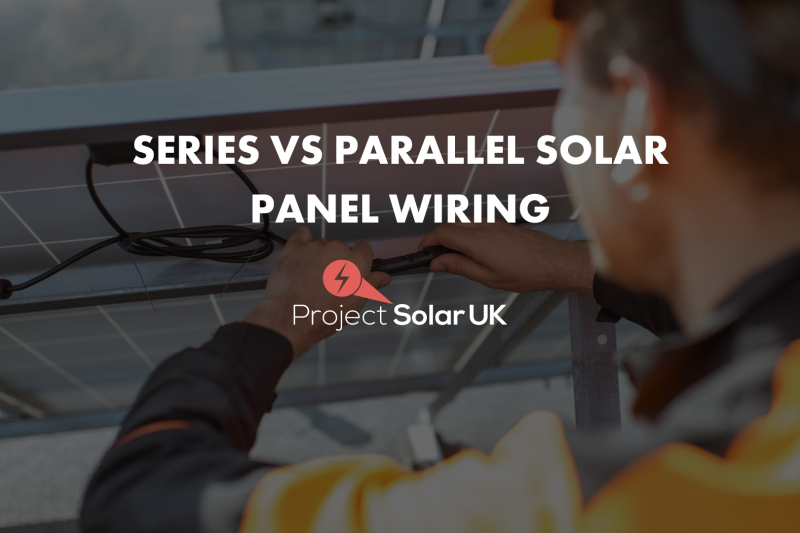There’s never been a better time to go green than in 2024. As the UK faces ecological challenges, residential and commercial properties can do their part for the planet by supplementing grid-generated electricity with solar panel power. But before you start reaping the rewards of this renewable source, a professional installer will need to decide what’s best for your home: series or parallel wiring. Luckily, at Project Solar, our highly qualified installers know exactly how to optimise your panel’s solar performance. Join us as we clarify what series and parallel wiring is and why a combination of the two approaches might be best.
What do series and parallel mean when it comes to solar panels?
The series wiring of solar panels involves connecting the positive terminal of one panel to the negative terminal of the next, creating a continuous string or chain. This setup increases the total voltage output of a solar array while keeping the current (also known as the ‘amperage’) the same as that of a single panel. The parallel wiring of solar panels, on the other hand, connects all positive terminals and all negative terminals together. This configuration keeps the voltage the same as a single panel but adds up the current from each panel.
Why would you put your solar panels in series?
Wiring solar panels in series means connecting them end-to-end so their voltage adds up while the current stays the same: this is beneficial for multiple reasons…
Higher voltage output
- Wiring solar panels in series increases the voltage output of the system while keeping the current (amps) constant. A series setup is ideal for systems that require a higher voltage to charge batteries or for configurations that are tied to the grid.
Reduced wire size
- As the current remains the same across all panels in a series circuit, you can use smaller gauge wires: this can save money on materials and make the installation process easier.
Increased efficiency over long distances
- Transmitting electricity over long distances often results in a voltage drop, which can decrease the efficiency of your solar power system.
- Wiring your solar panels in series helps mitigate this issue by maintaining a higher voltage level throughout the system, leading to more efficient power transmission.
Why would you put your solar panels in parallel?
Enhanced shadow tolerance
- Wiring panels in parallel helps mitigate the impact of shading on one or more panels.
- Unlike in series configurations, if one panel is shaded or underperforming, it doesn’t significantly reduce the output of the entire system. Each panel operates independently so the rest can continue producing power at full capacity.
Increased flexibility
- Parallel wiring allows for more design flexibility. You can mix different types of solar panels without affecting the overall system performance, and it’s easier to expand your system by adding more panels later on.
Reduced voltage drop
- When panels are wired in parallel, the voltage across the system remains consistent, reducing the potential for voltage drop over long cable runs.
Are solar panels in the UK usually in series or parallel?
In the UK, solar panel systems typically use a combination of both series and parallel connections: this approach means maximising the voltage and amperage without overwhelming the system’s inverter. It takes advantage of the increased output that series wiring can produce while also protecting potential shading issues through parallel connections.
How will putting your solar panels in series or parallel affect your savings?
Whether an installer chooses series or parallel wiring will depend on shading conditions and the way your solar system needs to be configured.To give the opportunity for annual savings, installers may choose to use series wiring if your panels will be mostly unobstructed (as this could lead to higher energy generation). However, if your panels are frequently shaded, an installer may instead use a parallel configuration to minimise the impact of shading on energy production. When you work with Project Solar, our installers will use their extensive knowledge and experience to choose the best configuration for your property.
Can you combine series and parallel solar panels?
Yes, you can combine series and parallel connections for solar panels to optimise the system’s voltage and current levels. A mixed approach means you can generate more power. Your installer will connect modules in series to achieve the required voltage level and then connect multiple strings in parallel to obtain the desired current level for the system. Configurations of these kinds can be particularly useful for large PV system plants where generating power in the range of gigawatts is required.
Expert installers are ready to help!
Deciding between series and parallel wiring is a technical task best left to your Project Solar installer. However, as a proud owner of green technology, keeping up to date with these concepts can make you more knowledgeable about the way modern solar technologies work. Start your green energy journey with our products, and let the UK’s largest and most accredited installer of solar panels make the technical choices for you.

